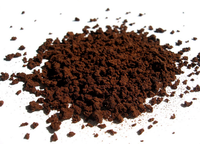








Instant coffee, also called soluble coffee and coffee powder, is a beverage derived from brewed coffee beans. Instant coffee is commercially prepared by either freeze-drying or spray drying, after which it can be rehydrated. Instant coffee in a concentrated liquid form is also manufactured.
Advantages of instant coffee include speed of preparation (instant coffee dissolves instantly in hot water), lower shipping weight and volume than beans or ground coffee (to prepare the same amount of beverage), and long shelf life — though instant coffee can spoil if not kept dry.
History
Instant or soluble coffee was invented and patented in 1890, by David Strang of Invercargill, New Zealand, under patent number 3518.It was sold under the trading name Strang's Coffee citing the patented "Dry Hot-Air" process. The invention was previously attributed to Satori Kato, a Japanese scientist working in Chicago in 1901. Kato introduced the powdered substance in Buffalo, New York, at the Pan-American Exposition.George Constant Louis Washington developed his own instant coffee process shortly thereafter, and first marketed it commercially (1910). The Nescafé brand, which introduced a more advanced coffee refining process, was launched in 1938.
High-vacuum freeze-dried coffee was developed shortly after World War II, as an indirect result of wartime research into other areas. The National Research Corporation was formed in Massachusetts as a process-development company employing high-vacuum technology. It developed high-vacuum processes to produce penicillin, blood plasma and streptomycin for US military use. As the war ended, NRC looked to adapt its processes for peacetime uses. It formed Florida Foods Corporation to produce concentrated orange juice powder, and originally sold its product to the United States Army. That company later changed its name to Minute Maid.
These days examples of popular instant coffee brands are Nescafé, International Roast, Extra, Folgers, Maxwell House, Robert Timms, Starbucks VIA and Kava (acid neutralized).
Use
Instant coffee is available in powder or granulated form contained in glass jars, sachets or tins. The user controls the strength of the resulting product, by adding more or less powder to the water, ranging from thin "coffee water" to very strong and almost syrupy coffee. A novel way is to use coffee bags, similar to tea bags.
Instant coffee is also convenient for preparing iced coffee like the Greek frappé, which is popular in warmer climates and hot seasons.
In some countries, such as Portugal, Spain and India, instant coffee is commonly mixed with hot milk instead of boiling water.In other countries, such as South Korea, instant coffee commonly comes pre-mixed with non-dairy creamer and sugar and is called "coffee mix".Said to have been popularised in the UK by GIs during World War II, instant coffee still accounts for over 75 percent of coffee bought to drink in British homes, as opposed to well under 10 percent in the U.S. and France and one percent in Italy.
The use of instant coffee also extends to both general cooking and even haute cuisine, because in many circumstances it is easier to apply. Coffee cake, with its coffee icing, is a staple of parties and festivities in its original New Zealand, in Australia and throughout Britain. Instant coffee easily flavours ice-cream and sundaes, and is often mixed with equal quantities of chocolate. Certain haute cuisine recipes call for instant coffee and paprika or turmeric rubs onto chicken, turkey or even venison. Chefs often note that in these cases, while ground beans offer a purer flavour to the aficionado, instant allows the permeation of flavour to be more evenly spread and consistent.